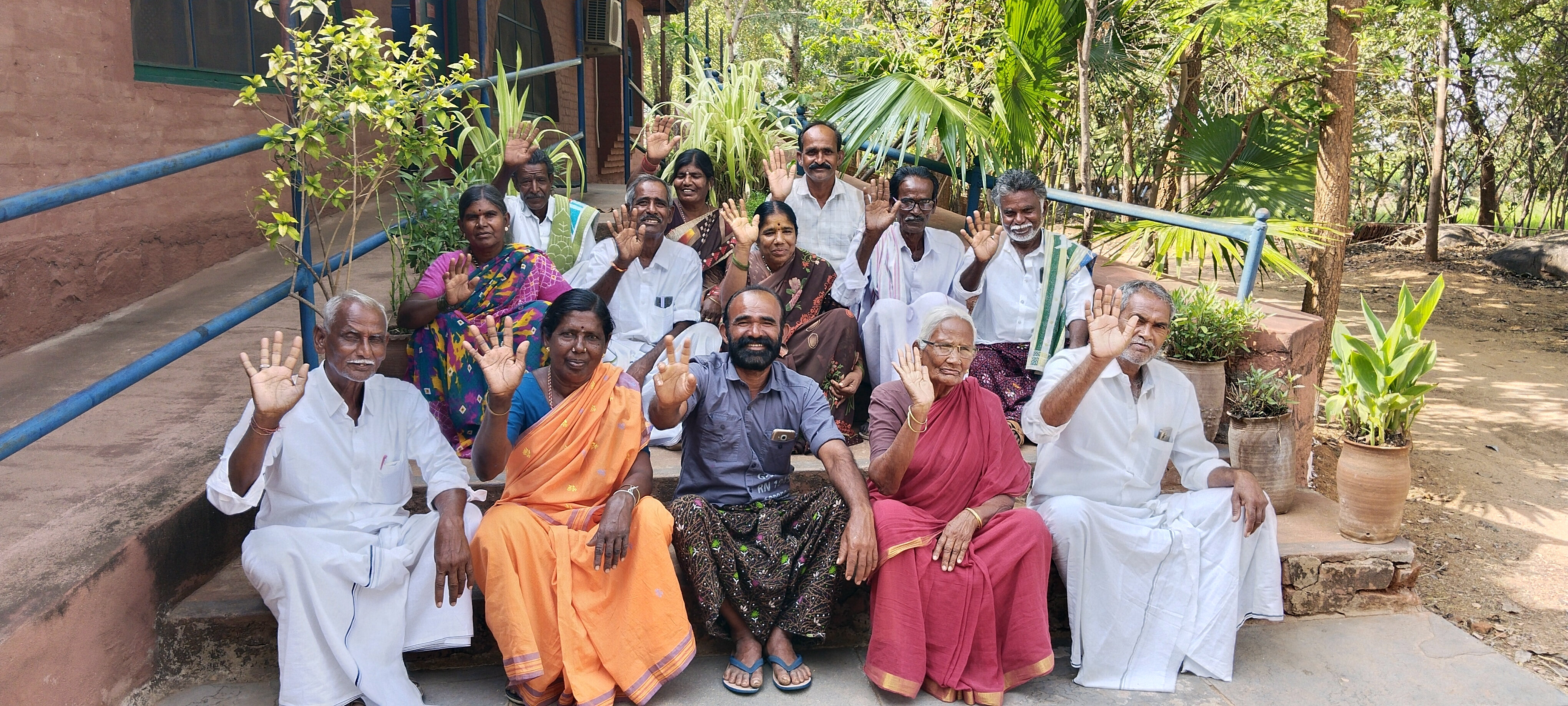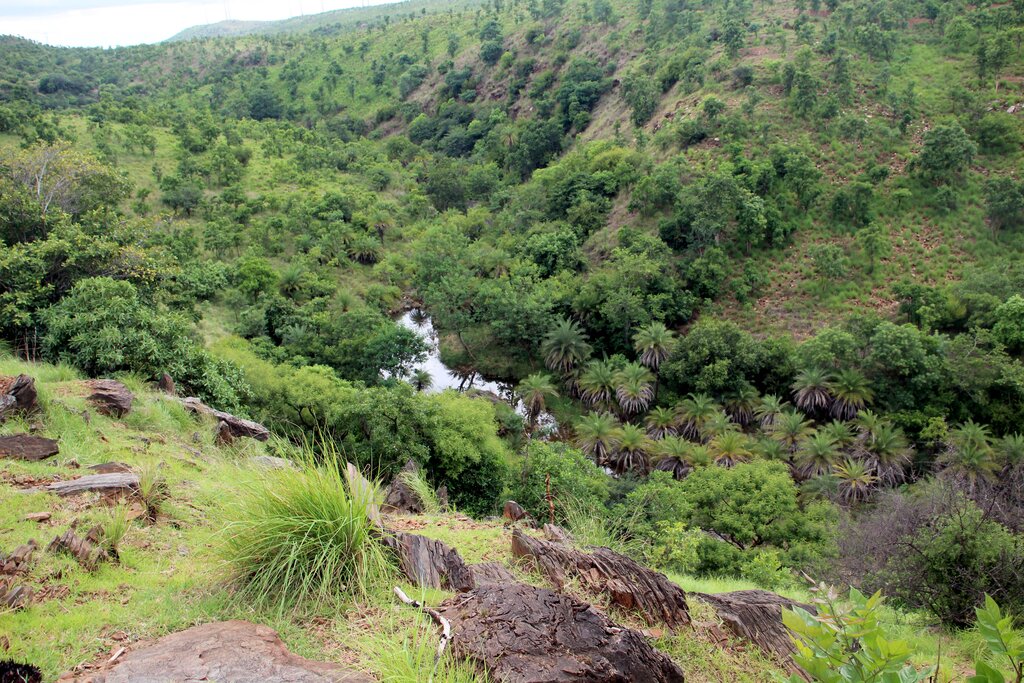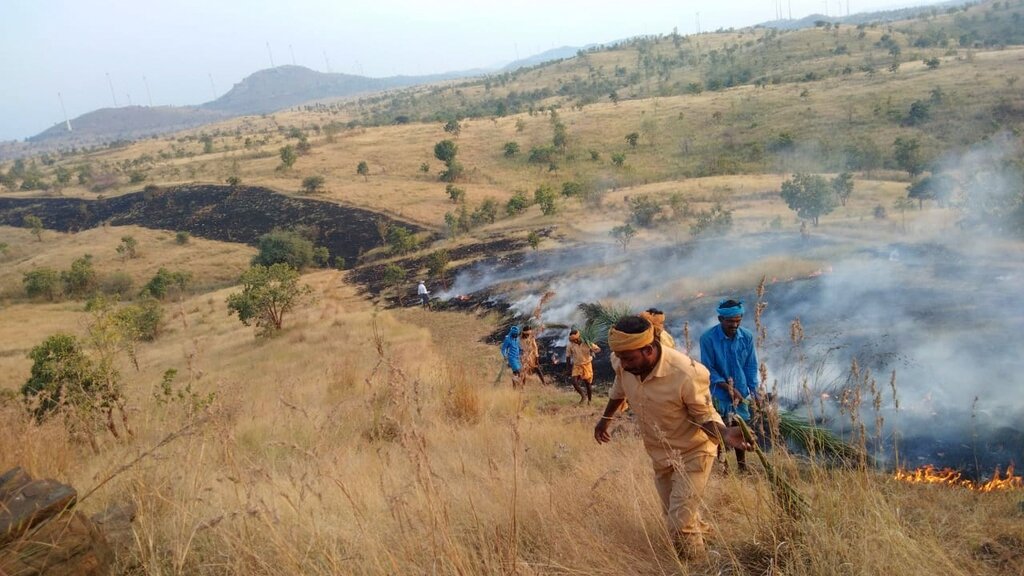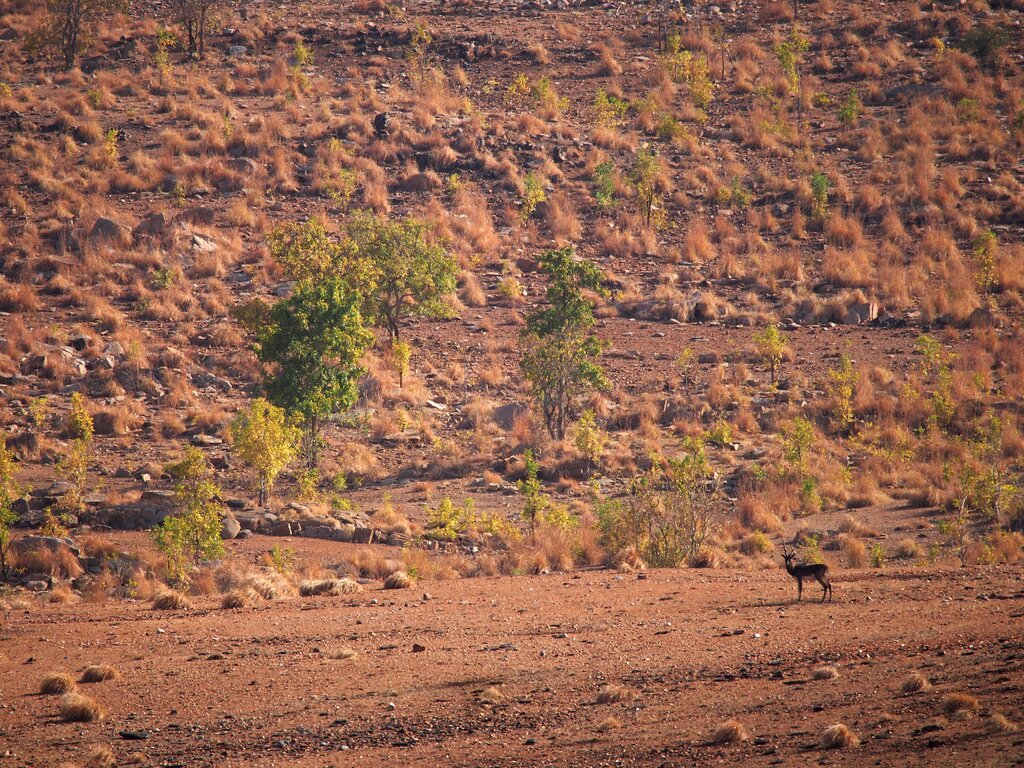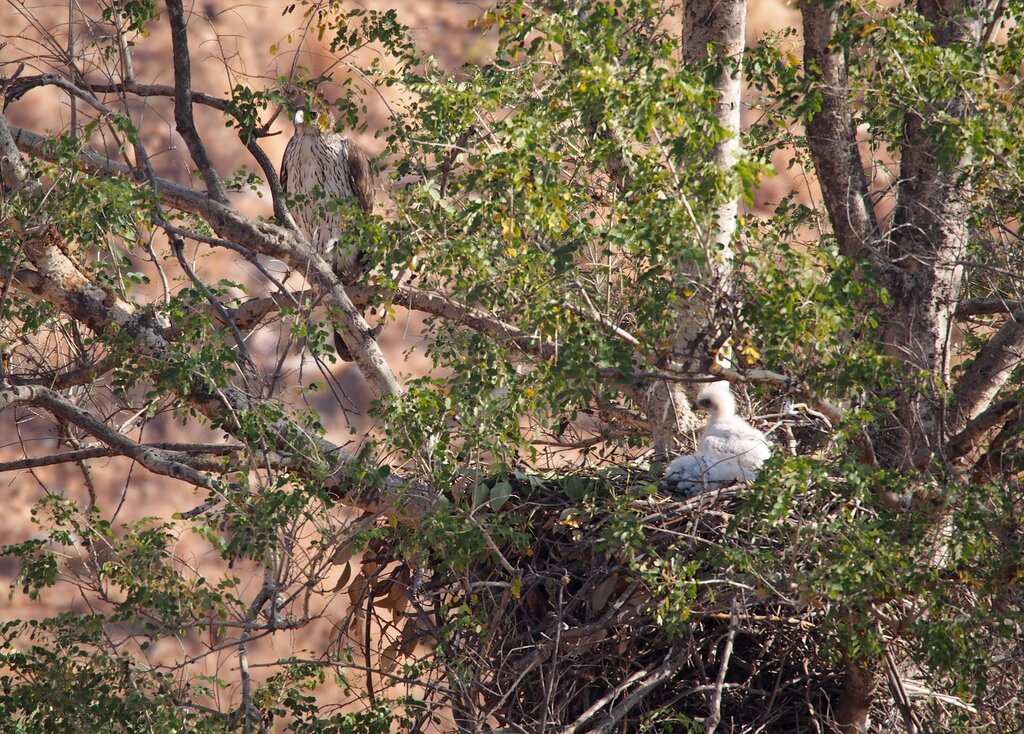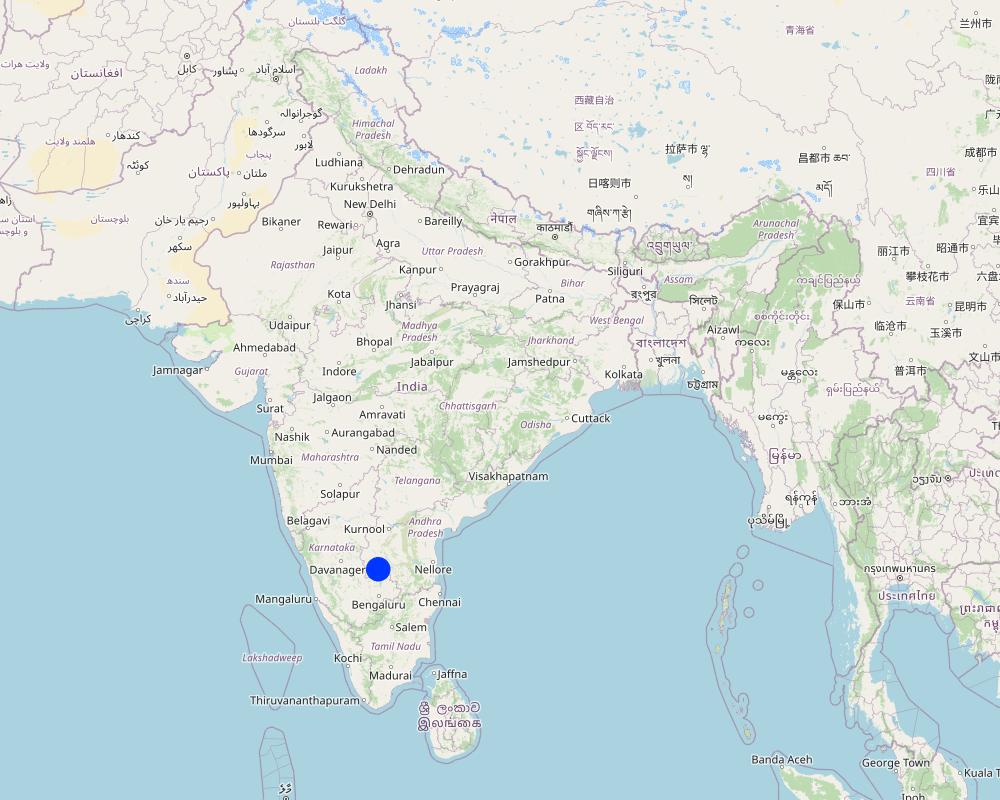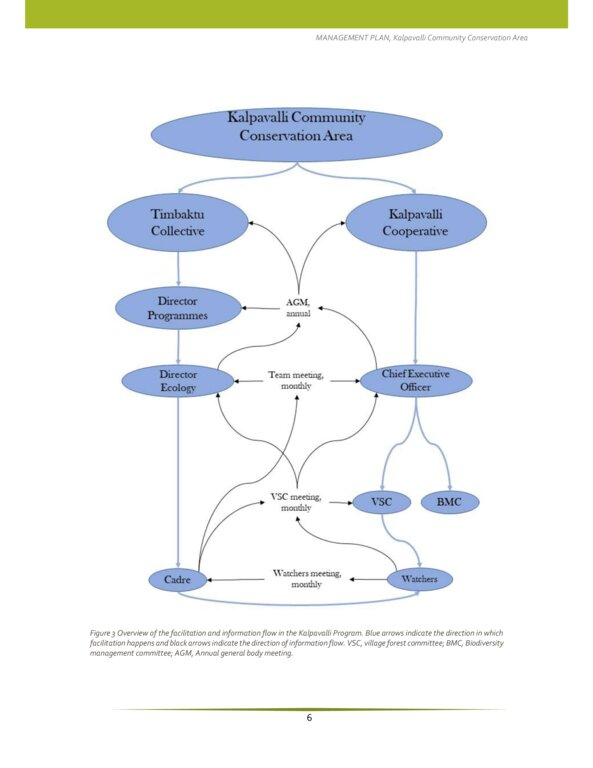Kalpavalli conservation approach: community-centred conservation of the commons [อินเดีย]
- ผู้สร้างสรรค์:
- การอัพเดท:
- ผู้รวบรวม: Manisha Kairaly
- ผู้เรียบเรียง: Nicole Harari
- ผู้ตรวจสอบ: William Critchley, Joana Eichenberger
Kalpavalli
approaches_6931 - อินเดีย
ดูส่วนย่อย
ขยายทั้งหมด ย่อทั้งหมด1. ข้อมูลทั่วไป
1.2 รายละเอียดที่ติดต่อได้ของผู้รวบรวมและองค์กรที่เกี่ยวข้องในการประเมินและการจัดเตรียมทำเอกสารของแนวทาง
ผู้เชี่ยวชาญ SLM:
Ganguly Choitresh
bablu@timbaktu.org
Timbaktu Collective
อินเดีย
ผู้เชี่ยวชาญ SLM:
Vattamattam Mary
mary@timbaktu.org
Timbaktu Collective
อินเดีย
co-compiler:
Rao Siddharth
sidsrao@gmail.com
Adavi Trust
อินเดีย
ชื่อของโครงการซึ่งอำนวยความสะดวกในการทำเอกสารหรือการประเมินแนวทาง (ถ้าเกี่ยวข้อง)
G20 Global Land Initiative (GLI) Course (GLI Course)ชื่อของโครงการซึ่งอำนวยความสะดวกในการทำเอกสารหรือการประเมินแนวทาง (ถ้าเกี่ยวข้อง)
G20 Global Land Initiative (GLI)ชื่อของโครงการซึ่งอำนวยความสะดวกในการทำเอกสารหรือการประเมินแนวทาง (ถ้าเกี่ยวข้อง)
Arugu (Arugu) - อินเดียชื่อของโครงการซึ่งอำนวยความสะดวกในการทำเอกสารหรือการประเมินแนวทาง (ถ้าเกี่ยวข้อง)
Adavi Trust (Adavi Trust) - อินเดีย1.3 เงื่อนไขที่เกี่ยวข้องกับการใช้ข้อมูลที่ได้บันทึกไว้ผ่านทาง WOCAT
วันที่เก็บรวบรวมข้อมูล (ภาคสนาม):
06/09/2023
ผู้รวบรวมและวิทยากรหลักยอมรับเงื่อนไขเกี่ยวกับการใช้ข้อมูลที่ถูกบันทึกผ่านทาง WOCAT:
ใช่
2. คำอธิบายของแนวทาง SLM
2.1 การอธิบายแบบสั้น ๆ ของแนวทาง
The Kalpavalli Community Conservation Area (KCCA) is a 6,500-acre (2,630 hectare) expanse of community-regenerated arid land located in the state of Andhra Pradesh in southern India. Over thirty years, participatory efforts have protected and restored this savannah ecosystem, with direct and indirect benefits to the community. This community-centred conservation of the commons is termed the Kalpavalli conservation approach.
2.2 การอธิบายอย่างละเอียดของแนวทาง
การอธิบายอย่างละเอียดของแนวทาง:
The Kalpavalli conservation approach is renowned for its focus on restoring common lands through the efforts of a cooperative society based on a federation of village forest committees. Community members are the beneficiaries. Through this approach, 6,500-acres (2,630 hectare) of arid and severely degraded common lands, have been successfully rejuvenated over the past 33 years. An NGO, Timbaktu Collective, has facilitated the conceptualisation and implementation of the approach.
The primary stakeholders are marginalized community members, including Dalits (the socially disadvantaged lowest castes), who have traditionally been landless labourers and pastoralists. Timbaktu Collective has played a critical role in community mobilization, capacity-building, training, and documentation. The approach empowered the lower castes to participate actively in the decision-making process and enabled them to advocate for benefits from government programmes. However, the lack of absolute ownership of the common lands and the potential influence of private parties with vested interests remain challenges.
The programme offers social and technical support. Details of the approach and its key focusses are as follows:
1. Social
Livelihoods: The Kalpavalli area is officially designated by the government as "wastelands", a contentious term which is applied to lands which the government does not consider economically productive. These lands are technically administrated by the State Government, but in most cases are either ignored or given to companies to establish factories or industrial estates. However, the Kalpavalli conservation approach ensures that traditional grazing and usage rights by communities are recognised. This facilitates sustainable land use centred on grazing, harvesting of non-timber forest produce, and more. The approach further promotes community management of common resources, joint responsibility for land protection, access to income generation from minor forest produce – all based on sustainable resource management.
Ownership and rights to resources: Grazing lands are largely under the technical ownership of the government, where traditional usage rights are permitted but not awarded legal status. The main challenge here is uncertainty about long-term ownership and rights to access. The approach therefore aims to secure usage, control, and ownership rights for the local community users. This is enabled through the creation of a community cooperative. The NGO and the cooperative have together been exploring various legal options to secure community ownership of the land.
Participation: The approach relies on social and technical methods, emphasizing community engagement. Social techniques include street theatre, community outings, participatory discussions, and voluntary service (“Shramadhanam”) to educate and mobilize the largely illiterate population.
Membership and monitoring: Members contribute an annual fee to access grazing and fuelwood collection. The approach includes policies for both protecting and monitoring common resources.
Organization development: Capacity-building, conflict resolution and organization management are facilitated through training and workshops.
Enterprise development: The community cooperative has launched eco-tourism initiatives to generate income, reinvesting profits into conservation efforts.
2. Technical
Restoration: The initial focus was on land protection, as common lands were degraded. In the initial years a key focus was on planting but then restoration work was modified as the land responded. Efforts have included protection from logging, creating firebreak lines, seed collection of native species, stream clearing, rotational grazing management, constructing rock-filled dams - and other watershed development work.
Protection of the commons: Stones were used to demarcate the land, and volunteer groups ("Vana Samrakshana Samithi") were established to prevent overgrazing and protect the area from uncontrolled fires.
Earthworks: Soil and water conservation measures such as rock-filled dams and earth bunds were introduced to reduce soil erosion and enhance groundwater recharge.
Research and management plans: Researchers helped map and share understanding of biodiversity. Biodiversity conservation, including both flora and fauna became a focus, with savannah ecology management plans developed.
Trees and vegetation: Initial attempts at using nurseries for propagation met with little success - and were replaced by seed broadcasting and propagation of local wild species. Seed huts were built to store seeds gather from this indigenous vegetation.
2.3 รูปภาพของแนวทาง
2.4 วีดีโอของแนวทาง
ความคิดเห็น อธิบายสั้นๆ:
https://www.youtube.com/watch?v=J-VtU46p9KA
short video on the Kalpavalli Project
ชื่อของผู้ถ่ายวีดีโอ:
Black Ticket Films
ความคิดเห็น อธิบายสั้นๆ:
https://www.youtube.com/watch?v=JZse_6PrGKg
About the conservation education work by the Timabktu Collective at the Kalpavalli Conservation Area
ชื่อของผู้ถ่ายวีดีโอ:
Timbaktu Collective
ความคิดเห็น อธิบายสั้นๆ:
https://www.youtube.com/watch?v=l7s4VIqtpLA
A short video on the wildlife conservation work at the Kalpavalli Conservation Area
2.5 ประเทศ ภูมิภาค หรือสถานที่ตั้งที่ได้นำแนวทางไปใช้
ประเทศ:
อินเดีย
ภูมิภาค/รัฐ/จังหวัด: :
Andhra Pradesh
ข้อมูลเฉพาะเพิ่มเติมของสถานที่ตั้ง:
Anatapuram District
Map
×2.6 วันที่เริ่มต้นและสิ้นสุดของแนวทาง
ระบุปีที่เริ่ม:
1992
ความคิดเห็น:
Ongoing
2.7 ประเภทของแนวทาง
- Mixed using all three of the above
2.8 เป้าหมายหรือวัตถุประสงค์หลักของแนวทาง
Water and Soil Conservation
Community-Led Conservation
Common Land Protection
Wildlife Conservation
Livelihood Generation
Empowerment of Local Communities
2.9 เงื่อนไขที่เอื้ออำนวยหรือเป็นอุปสรรคต่อการนำเทคโนโลยีภายใต้แนวทางนี้ไปปฏิบัติใช้
บรรทัดฐานและค่านิยมทางสังคม วัฒนธรรม ศาสนา
- เอื้ออำนวย
Cultural practises such as sramadhanam (volunteering physical labour for a common goal), vanabhojanam (feasts in the forest), Sacred Groves, Kattubaatu (group decisions and social agreements that everyone decides to honour)
- เป็นอุปสรรค
Lack of agency for women, caste system
การมีไว้ให้หรือการเข้าถึงแหล่งการเงินและบริการ
- เอื้ออำนวย
The most important factor to note, especially as a resource, was the Timbaktu campus serving as an active ecology lab. A lot of knowledge was transferred from this site to the hills of Kalpavalli. All the technologies implemented were done with locally available skills, labour and materials. Therefore, the costs were minimal.
- เป็นอุปสรรค
Initially it was difficult for the members to raise capital/ group savings by themselves. In light of this, the NGO fundraised small amounts to help the works undertaken, especially for wages and salaries of members. Additionally, being a low priority landscape, (these swathes of land are even called ‘wastelands’) it was difficult to raise large amounts for restoration works as it did not at that time capture the imagination of the population nor the Government.
การจัดตั้งระดับองค์กร
- เอื้ออำนวย
The different technologies of the watershed concept such as gully plugs, greening, conservation, rock filled dams water flow delay and absorption were modified and adapted to this particular landscape thanks to having an institutional setting and back up. It served as an interface to acquire the knowledge and then systematically implement it on the field.
Having the institutional setting also allowed for the technological interventions to be suggested to the Government bodies for watershed works. It also worked in the favour of the approach that institutionally as well, these were not only ideas or concepts shared but were also actively being worked on in the field, which added to its credibility.
การร่วมมือหรือการทำงานประสานกันของผู้ลงมือปฏิบัติ
- เอื้ออำนวย
The Community members (Forest Protection Committee) , the NGO, the Village level Panchayat, local Universities and the Government were all involved in these processes. If any of these actors did not cooperate then this approach would not have been possible. The larger goal of communities working towards ‘ greening’ was what largely aided this collaboration between various actors to occur
กรอบแนวทางในการดำเนินการด้านกฎหมาย (การถือครองที่ดิน สิทธิในการใช้ที่ดินและน้ำ)
- เอื้ออำนวย
The concept of ‘land use for the commons’, village common lands.
- เป็นอุปสรรค
Technically the land belongs to the Government. So even if the community actively works and restores it, even for 3 decades, the ownership will not rest with them. Here are a few examples in how this has proved to a hindrance so far:
Land grab by private windmill companies
Green tribunal windmill case, though won, did not get payment to the community
Government granted sections of land to the Forest Department in the conservation area.
Electricity Department granted area to lay high power cables through wolf and blackbuck habitat
นโยบาย
- เอื้ออำนวย
That the Common lands were for use by the village and came under the Revenue Department which grants usage rights. This enabled all the works to be undertaken without any backlash from upper castes in the village.
That the Sacred Groves come under the Endowment Lands, which also aided the protection of the wild lands surrounding them.
The Village Panchayat in tandem with the BMC (Biodiversity Management Committees) are a newer body that by policy of the regional and national Government follows an International agreement on Local bodies having the onus of maintaining and protecting their local biodiversity.
NREGA – employment guarantee scheme
FFW – Food for Work scheme
Watershed Scheme by the regional Government.
- เป็นอุปสรรค
Lack of understanding about the delicate nature of Grassland ecosystems and lesser known/ low priority landscapes
Lack of information of how these landscapes actually impact and enable livelihoods for many sections of the lower castes in the community
Demarcation of these lands as ‘waste lands’
การกำกับดูแลที่ดิน (การตัดสินใจ การนำเอาไปปฏิบัติใช้ และการบังคับใช้)
- เอื้ออำนวย
Institution of the Forest Protection Committee as a Cooperative, creation of Community Management Plans with the help of experts, social norms such as ‘Ummadi Bhoomi’ – common land maintenance, clear roles and responsibilities of the various members of the committees.
- เป็นอุปสรรค
Lack of legal ownership. Although the India state has a progressive Forest Rights Act, which can enable indigenous communities to gain access to traditional lands this does not apply to this region as the village members are not classified as "Tribals" as per Indian law.
Very difficult to deal with encroachments or to get the external parties to comply with the conservation area’s protection protocols.
Legitimacy of ownership is always questioned due to this factor.
ความรู้เกี่ยวกับ SLM การเข้าถึงการสนับสนุนด้านเทคนิค
- เอื้ออำนวย
Having the NGO to play the role of facilitator and to interface with universities and donors allowed for the knowledge systems to be more easily shared and disseminated in field.
- เป็นอุปสรรค
Distance of the Kalpavalli area, which is very rural. Until 2011, there were no roads as well and so anyone willing to do this work and share knowledge had to be able to hike and walk large distances to see the work being done.
ตลาด (จัดซื้อปัจจัยนำเข้า ขายผลิตภัณฑ์) และราคา
- เอื้ออำนวย
Very low market dependence and very low market orientation as well. Local markets were easy to approach for sale of seasonal produce.
ปริมาณงานที่ทำได้ กำลังคนที่มีให้
- เอื้ออำนวย
Definitely enabling as for the earthworks taken up by the members of the community, they received wages from various government schemes and grants raised by the NGO Timbaktu Collective. Hardly any machines were used so the large majority of the works done served as a livelihood for the members.
อื่นๆ
- เอื้ออำนวย
Repetition of the various technologies, such as trenches, rock filled dams, fire lines, seed collection and dibbling and so forth allowed for these methods to become part of the inhouse knowledge. Developing these packages of practises by the community members and team have perfected these technologies and can easily implement the process on field.
3. การมีส่วนร่วมและบทบาทของผู้มีส่วนได้ส่วนเสียที่เกี่ยวข้อง
3.1 ผู้มีส่วนได้ส่วนเสียที่เกี่ยวข้องในแนวทางนี้และบทบาท
- ผู้ใช้ที่ดินระดับท้องถิ่นหรือชุมชนระดับท้องถิ่น
10 local village groups all from marginalised lower castes.
Watch and ward, land management and participatory processes.
- องค์กรที่ขึ้นอยู่กับชุมชน
The Kalpavalli Tree Growers Cooperative (registered name) comprising over 250 members. Also referred to as the 'Cooperative or community Cooperative' in various places in this document.
Mobilisation, management and participatory processes.
- ผู้เชี่ยวชาญ SLM หรือที่ปรึกษาการเกษตร
Researchers, academics and university groups.
SLM technologies, trainings, data collection.
- นักวิจัย
inhouse and external ecologists and social scientists
documentation and SLM
- องค์กรพัฒนาเอกชน
The timbaktu collective
ideation, catalyst, implementation, technical, administrative, financial and logistical support.
- รัฐบาลระดับท้องถิ่น
Local Panchyath, District Collector, Block Education officer
legal owners of land, facilitate education and help with conflict management.
- องค์การระหว่างประเทศ
Interntional donor agencies
funding, monitoring and evaluation.
3.2 การเกี่ยวข้องของผู้ใช้ที่ดินระดับท้องถิ่นหรือชุมชนระดับท้องถิ่นในช่วงต่างๆของแนวทาง
| ความเกี่ยวข้องของผู้ใช้ที่ดินระดับท้องถิ่นหรือชุมชนระดับท้องถิ่น | ระบุผู้ที่มีส่วนเกี่ยวข้องและอธิบายกิจกรรม | |
|---|---|---|
| การริเริ่มหรือการจูงใจ | ปฏิสัมพันธ์ | Village community members as well as the NGO team came together to understand land degradation and its impacts on the community. They started working on the watershed to conserve water. |
| การวางแผน | ปฏิสัมพันธ์ | The community and NGO planned activities such as tree planting, grass seed dibbling, fire management. They collectively mobilised volunteers for this. |
| การดำเนินการ | ปฏิสัมพันธ์ | The community members and NGO partnered to implement all restoration work from the beginning of the project. They created a cooperative dedicated to the restoration of the selected common lands, hired the required labor as well as contributed voluntarily to the restoration activities. These are ongoing till date, including planting, protection, critical watering, fire and grazing management. |
| การติดตามตรวจสอบหรือการประเมินผล | ปฏิสัมพันธ์ | Daily monitoring of the commons is undertaken by the community watchers and community members work alongside any researchers who are monitoring or collecting data. |
| Research | ปฏิสัมพันธ์ | All research is discussed in advance with the community directors and community watchers are part of the data collection process. research results are shared with the community. |
3.3 แผนผังแสดงขั้นตอนการทำงาน (ถ้ามี)
คำอธิบาย:
Overview of the facilitation and information flow in the Kalpavalli Programme, excerpt from the Kalpavalli Management Plan
ผู้เขียน:
Sreenivasan & Rao
3.4 การตัดสินใจเลือกใช้เทคโนโลยี SLM
ระบุผู้ที่ทำการตัดสินใจเลือกเทคโนโลยีมากกว่าหนึ่งวิธีไปปฏิบัติใช้:
- ผู้ลงมือปฏิบัติที่เกี่ยวข้องทั้งหมดในฐานะที่เป็นส่วนรวมของแนวทาง
ระบุว่าการตัดสินใจตั้งอยู่บนพื้นฐานของ:
- ประสบการณ์และความคิดเห็นส่วนตัว (ไม่ได้ลงบันทึกไว้)
4. การสนับสนุนด้านเทคนิค การสร้างขีดความสามารถ และการจัดการด้านความรู้
4.1 การสร้างขีดความสามารถ / การอบรม
ได้มีการจัดอบรมให้แก่ผู้ใช้ที่ดินหรือผู้มีส่วนได้ส่วนเสียคนอื่น ๆ หรือไม่:
ใช่
ให้ระบุว่าใครเป็นผู้ได้รับการอบรม:
- ผู้ใช้ที่ดิน
- เจ้าหน้าที่ภาคสนาม / ที่ปรึกษา
รูปแบบการอบรม:
- กำลังดำเนินการ
- เกษตรกรกับเกษตรกร
- ใช้พื้นที่ทำการสาธิต
- จัดการประชุมสู่สาธารณชน
- จัดคอร์ส
หัวข้อที่พูด:
Seed preservation and collection, grassland and rangeland management and ecology, wildlife conservation, bird watching, aquatic ecology, human-wildlife conflict, GIS basics, ecotourism, gender training, evolutionary biology.
4.2 การบริการให้คำแนะนำ
ผู้ใช้ที่ดินมีการเข้าถึงการรับบริการให้คำปรึกษาหรือไม่:
ใช่
ระบุว่ามีบริการให้คำปรึกษาหรือไม่:
- ไปเยี่ยมชมสถานที่
- ที่ศูนย์ถาวร
การอธิบาย/แสดงความคิดเห็น:
The NGO Timbaktu Collective makes coordinates and links the land users to specific expertise and advisor services as and when requested or required. this includes universities, other NGOS, researchers and government officials.
4.3 การเสริมความแข็งแกร่งให้กับสถาบัน (การพัฒนาองค์กร)
สถาบันได้รับการจัดตั้งขึ้นมาหรือเสริมความแข็งแกร่งโดยแนวทางนี้หรือไม่:
- ใช่ อย่างมาก
ระบุระดับของสถาบันที่ได้รับการเสริมความแข็งแกร่งหรือจัดตั้งขึ้นมา:
- ท้องถิ่น
อธิบายถึงสถาบัน บทบาทและความรับผิดชอบ สมาชิก เป็นต้น:
The Kalpavalli area is managed by the Kalpavalli Tree Grower’s Cooperative Society which is a federation of 10 Vana Samrakshana (Forest Protection) Committees. Their primary role is the decentralized management of their common lands.
The VSCs and the Cooperative were established by the Timbaktu Collective, under the Andhra Pradesh State "Mutually Aided-Cooperative Act" to create participatory decision making processes in the villages for the common lands. The VSCs partner with the Timbaktu Collective for technical, administrative, financial and logistical requirements while they continue to function independently and in parallel to the local Biodiversity Management Committees (BMC). The BMC's are in essence the same members as the VSC, the difference is that the BMC are legal entities under the Biological Diversity Act of the central government. This was an act passed only in 2002. The NGO Timbaktu Collective has been finding different strategies to strengthen village institutions based on available laws. The Cooperative monitors the use of the Kalpavalli forests through its Watch and Ward policy. This encompasses field level forest watchers appointed by the VSCs and entrusted with the responsibility of overseeing a specific area. The forest Watchers undertake patrolling, monitor forest activities, seasonal NTFP collection and collaborate extensively with the NGO team members.
ระบุประเภทของการให้ความช่วยเหลือสนับสนุน:
- ด้านการเงิน
- การสร้างขีดความสามารถ / การอบรม
- อุปกรณ์
4.4 การติดตามตรวจสอบและประเมินผล
การติดตามตรวจสอบและประเมินผลเป็นส่วนหนึ่งของแนวทางหรือไม่:
ใช่
ความคิดเห็น:
There are internal and external processes to monitor and evaluate the project. The internal ones are, weekly, monthly and yearly team reviews by the Timbaktu Collective. The Coopertive Directors Meet every month to review progress and strategies. The timbaktu collective also organises for periodic monitoring and evaluation from external consultants on a case-by-case basis. External mentoring and evaluation is largely done by funding agencies on a yearly basis.
ถ้าตอบว่าใช่ แสดงว่าการจัดเตรียมเอกสารนี้มุ่งหวังที่จะเอาไปใช้สำหรับการติดตามตรวจสอบและประเมินผลใช่หรือไม่:
ใช่
ความคิดเห็น:
This document will serve as a reference for the NGO and the cooperative as well as help document their work.
4.5 การวิจัย
การวิจัยเป็นส่วนหนึ่งของแนวทางหรือไม่:
ใช่
ระบุหัวข้อเรื่อง:
- สังคมวิทยา
- เศรษฐศาสตร์หรือการตลาด
- นิเวศวิทยา
ให้ข้อมูลเพิ่มเติมและให้ระบุผู้ทำการวิจัย:
From the year 2008, several formal research projects were taken up in the Kalpavalli area. One of the first was to do a physical walk along with marked locations along the BURUJULU (boundary markings) in order to make a GPS map. Post that, in 2013 there was a Biodiversity assessment done for both flora and fauna. Soon after a Wolf and Vulture questionnaire was carried out among land users and other community members to understand villager’s mindsets towards these two threatened species. The findings, along with other smaller questionnaires were compiled into another research study and report that outlined a Management Plan for the Kalpavalli Cooperative. Fauna specific research with camera trapping and field notes allowed Researchers to establish Kalpavalli as a critical habitat and corridor, especially for the vulnerable Indian Grey Wolf.
Most of the research over the years was carried out by Independent Ecologists and Wildlife Biologists. Mr. Siddharth Rao, Naren Sreenivasan, Gautham Gollapalli and Joseph Vattakaaven are among the researchers who have done extensive work on the Kalpavalli approach.
5. การสนับสนุนด้านการเงินและวัสดุอุปกรณ์
5.1 ระบุงบประมาณประจำปีสำหรับแนวทาง SLM นี้
ถ้าหากว่างบประมาณประจำปีไม่เป็นที่ทราบแน่นอน ให้ระบุช่วงลงไป:
- 10,000-100,000
แสดงความคิดเห็น (แหล่งของการระดมทุน ผู้บริจาคคนสำคัญ):
The NGO was and is funded by various donor agencies (international and national) a well as philanthropists. All funding information is published annually on www.timbuktu.org. With respect to Nrega and FFW the NGO served as the implementing agency chosen by the government. This was completed in the 2000s.
5.2 การสนับสนุนด้านการเงิน / วัสดุอุปกรณ์ให้แก่ผู้ใช้ที่ดิน
ผู้ใช้ที่ดินได้รับการสนับสนุนด้านการเงิน / วัสดุอุปกรณ์ไปปฏิบัติใช้เทคโนโลยีหรือไม่:
ใช่
ถ้าใช่ ให้ระบุประเภทของการสนับสนุน เงื่อนไขและผู้จัดหามาให้:
The NGO Timbaktu Collective has raised grants to support salaries for watch and ward, holding meetings, purchasing equipment and other logistical support.
5.3 เงินสนับสนุนสำหรับปัจจัยนำเข้า (รวมถึงแรงงาน)
- แรงงาน
| เห็นด้วยระดับไหน | ระบุเงินสนับสนุน |
|---|---|
| ได้รับการช่วยเหลือทางการเงินบางส่วน | NREGA and Food For Work Programmes |
ถ้าแรงงานโดยผู้ใช้ที่ดินเป็นปัจจัยนำเข้าที่มีอยู่มากมาย ระบุด้วยว่าเนื่องจาก:
- สมัครใจ
ความคิดเห็น:
In the intial years most labour was volluntary, which then moved to paid labour and some voluntary commitments from the community.
5.4 เครดิต
มีการจัดหาเครดิตมาให้ภายใต้แนวทาง SLM หรือไม่:
ไม่ใช่
5.5 แรงจูงใจหรือเครื่องมืออื่น ๆ
แรงจูงใจหรือเครื่องมืออื่น ๆ ได้ถูกนำไปใช้ส่งเสริมการใช้เทคโนโลยี SLM หรือไม่:
ใช่
ถ้าใช่ ระบุ:
The NREGA Act and The Food for work Government programme
6. การวิเคราะห์ผลกระทบและการสรุป
6.1 ผลกระทบของแนวทาง
ทำให้ผู้ใช้ที่ดินระดับท้องถิ่นมีอำนาจขึ้น ปรับปรุงการเข้าร่วมของผู้มีส่วนได้ส่วนเสียให้ดีขึ้นหรือไม่:
- ไม่ใช่
- ใช่ เล็กน้อย
- ใช่ ปานกลาง
- ใช่ อย่างมาก
Prior to the approach, these specific communities and castes were not involved in discussions or decisions based in and around their villages. Over the years, the land users feel all decisions regarding their common resources such as fodder, thatch grass, streams and waterways were all made in a participatory fashion, and led by the lower caste members.
ช่วยในการตัดสินใจโดยดูจากหลักฐาน ได้หรือไม่:
- ไม่ใช่
- ใช่ เล็กน้อย
- ใช่ ปานกลาง
- ใช่ อย่างมาก
Yes. This was because of seeing the effects of various technologies taking shape on the landscape and then slowly increasing the area of the Commons that were added to be protected and nurtured. Photo documentation helped monitor and share results to make it easier to implement more evidence based decision making possible, especially for the illiterate community members. Researchers documenting and collecting data has helped this process.
ช่วยให้ผู้ใช้ที่ดินนำเอาเทคโนโลยี SLMไปใช้และบำรุงรักษาสภาพไว้ได้หรือไม่:
- ไม่ใช่
- ใช่ เล็กน้อย
- ใช่ ปานกลาง
- ใช่ อย่างมาก
Yes. Having the support of the NGO team members to help oversee and propagate technologies allowed for more village groups to get involved in healing the lands closest to their area. This had various impacts such as mobilizing the community as well maintaining all records for any incentive-based work to be immediately reimbursed. This built trust as well to maintain the SLM technologies once implemented.
ปรับปรุงความร่วมมือกันและการดำเนิน งานของ SLM ได้อย่างมีประสิทธิผลหรือไม่:
- ไม่ใช่
- ใช่ เล็กน้อย
- ใช่ ปานกลาง
- ใช่ อย่างมาก
Definitely. Having a strategic approach to the technologies meant that existing social norms and cultures were used in a participatory way. Examples are shramadaanam (voluntary work for a specific goal such as making making fire lines), desilting waterbodies in the dry season, putting out fires using existing techniques such as green palm fronds etc. If these methodologies were not used in a resourceful manner, all the technologies would have proved much more expensive to implement in field.
ระดมกำลังหรือปรับปรุงการเข้าถึงแหล่ง เงินทุนสำหรับการดำเนินการ SLM หรือไม่:
- ไม่ใช่
- ใช่ เล็กน้อย
- ใช่ ปานกลาง
- ใช่ อย่างมาก
Prior to the approach, this land area was degraded and unmanaged for any returns, tangible and intangible. By starting the initial village groups, members put together small savings to carry out certain activities while the NGO also raised funds for the same. This process greatly helped to initiate and then continue to mobilize financial resources. Currently, the Eco tourism model also follows the same ideology of mobilizing funds for SLM in the area.
ปรับปรุงความรู้และความสามารถของผู้ใช้ที่ดินในการดำเนินการ SLM หรือไม่:
- ไม่ใช่
- ใช่ เล็กน้อย
- ใช่ ปานกลาง
- ใช่ อย่างมาก
Yes definitely. Building on a few existing technologies, the SLMs introduced were simple, practical and enabled community members to easily join in the process.
ปรับปรุงความรู้และความสามารถของผู้มีส่วนได้ส่วนเสียคนอื่น ๆ ให้ดีขึ้นหรือไม่:
- ไม่ใช่
- ใช่ เล็กน้อย
- ใช่ ปานกลาง
- ใช่ อย่างมาก
Village members who are not part of these committees were also impacted by these activities as awareness grew about restoration practises and methods to aid the process.
ทำให้ผู้ใช้ที่ดินระดับท้องถิ่นมีอำนาจขึ้น ปรับปรุงการเข้าร่วมของผู้มีส่วนได้ส่วนเสียให้ดีขึ้นหรือไม่:
- ไม่ใช่
- ใช่ เล็กน้อย
- ใช่ ปานกลาง
- ใช่ อย่างมาก
Yes definitely. The Cooperative approach intrinsically is a people led structure that is open to sharing knowledge and involving others in processes. The community, NGO, Government as well as other stakeholders such as migratory pastoralists, research organizations, farmer cooperatives, Cooperative of People with disabilities and local Government school children are all stakeholders with whom collaboration has been initiated and strengthened.
ช่วยบรรเทาความขัดแย้งหรือไม่:
- ไม่ใช่
- ใช่ เล็กน้อย
- ใช่ ปานกลาง
- ใช่ อย่างมาก
Significantly. In the initial years conflicts arose between villages over shared resources such as fodder and thatch grass. These were resolved by interventions from the NGO members. In later years, conflicts with windmill owners, private quarry owners, political parties looking to grab land were all dealt with in a peaceful manner with dialogue and exerting land use rights at the fore.
ทำให้กลุ่มด้อยโอกาสมีอำนาจทางสังคมและเศรษฐกิจหรือไม่:
- ไม่ใช่
- ใช่ เล็กน้อย
- ใช่ ปานกลาง
- ใช่ อย่างมาก
Yes significantly. Kalpavalli works in 10 villages and in these villages with the most socially and economically marginalized communities. The Village members as well as traditional migratory pastoralists make regular income as well as livelihood supports thanks to this approach. The land users feel that this approach has had both immediate as well as long term benefits for socially and economically backward groups.
ปรับปรุงความทัดเทียมกันด้านเพศและให้อำนาจแก่ผู้หญิงและเด็กผู้หญิงหรือไม่:
- ไม่ใช่
- ใช่ เล็กน้อย
- ใช่ ปานกลาง
- ใช่ อย่างมาก
In the initial years, men were reluctant to have women join the discussions in the ‘male dominated’ areas of the village where meetings usually took place. Women too were hesitant to participate in these gatherings. However, they were encouraged to join in, especially as they were the ones doing rounds to collect firewood and fodder for the homestead. Slowly, they got involved and today play an important role in the leadership. However, daily patrol, watch and ward work is not undertaken by them due to safety concerns. School girls were encouraged to join day long SLM activities such as seed broadcasting and collection which was absolutely not common before. Some members pointed out that gender equality trainings by the NGO opened their eyes to shared leadership and responsibility of the commons.
ส่งเสริมให้เยาวชนหรือบุตรหลานของผู้ใช้ที่ดินให้เข้าร่วมใน SLM:
- ไม่ใช่
- ใช่ เล็กน้อย
- ใช่ ปานกลาง
- ใช่ อย่างมาก
Many members encourage their children to attend the camps and awareness workshops that the Ngo organize. The focus of these is on grassland biodiversity and ecosystems along with fun games, activities and cultural dances and songs that celebrate nature. These training camps has had several hundred children and youth attend and has fostered a strong connection with their wild and common lands
ปรับปรุงประเด็นของการถือครองที่ดินหรือสิทธิในการใช้ ซึ่งขัดขวางการนำเทคโนโลยีไปใช้ให้ดีขึ้น:
- ไม่ใช่
- ใช่ เล็กน้อย
- ใช่ ปานกลาง
- ใช่ อย่างมาก
Land tenure was not impacted but user rights were strongly bolstered. Community members never undertook measures to heal the land while it was just listed as the Commons. Since this approach, the fact that the land was restored and proved to become a massive resource for the community definitely improved user rights. As for tenure, it still comes under the Government.
นำไปสู่ความมั่นคงด้านอาหารหรือปรับปรุงโภชนาการให้ดีขึ้น:
- ไม่ใช่
- ใช่ เล็กน้อย
- ใช่ ปานกลาง
- ใช่ อย่างมาก
Community members interviewed for this case study pointed out two distinct ways in which the approach has led to food security. One is that the protection and management of the streams and the check-dams has ensured that the watershed works well every monsoon with sufficient water collection in the big lakes downstream. The water from here is used by the farming community to grow a variety of greens and vegetables that are then mostly sold locally in the village itself. The other factor they pointed out was that abundance of fodder for small ruminants has ensured that meat consumption, especially of free-range goat and sheep mutton has been possible thanks to this approach. In other villages, pooer sections of the community have no other protein source than to buy cheaper farmed ‘broiler chicken’ meat, which is weak in nutrition and pumped with a lot of steroids and antibiotics.
ปรับปรุงการเข้าถึงตลาดหรือไม่:
- ไม่ใช่
- ใช่ เล็กน้อย
- ใช่ ปานกลาง
- ใช่ อย่างมาก
In this regards, the traditional market access for NTFP was strengthened. Livelihoods from seasonal broom grass collection, thatch grass, palm fronds for mats and basket weaving, wild berries and various flora for ethno- veterinary preparations have all been helped. The collection and sale of these have certainly increased the access to markets for these sections of the community, especially women from the lower castes. Additionally, market-based solutions such as an eco-tourism venture withing the conservation area is up and running. This provides revenue to the Coopertive from tourist who visit the restoration site. All this work in relation to markets has been led by the Timbaktu Collective.
นำไปสู่การเข้าถึงเรื่องน้ำและสุขาภิบาลได้ดีขึ้นหรือไม่:
- ไม่ใช่
- ใช่ เล็กน้อย
- ใช่ ปานกลาง
- ใช่ อย่างมาก
Access to water yes. Sanitation not necessarily as that comes under the management of the Municipality of the local government bodies. The SLMs in the approach have had a massive impact on consistent water levels in the entire watershed as well as recharging the underground aquifers.
นำไปสู่การใช้ที่ดินอย่างยั่งยืนหรือแหล่งพลังงานหรือไม่:
- ไม่ใช่
- ใช่ เล็กน้อย
- ใช่ ปานกลาง
- ใช่ อย่างมาก
As a lot of the SLMs were taken from the Timbaktu handbook, solar powered spaces were a big take away. All infrastructure in the Kalpavalli area is solar powered
From the second year onwards, the community could depend on the Kalpavalli restoration for fodder for the huge populations of small ruminants in the area as well as cattle. Extreme heat and drought years have seen this area still have fodder grass and perennial streams that are a life saver for pastoralists. Community members engaged with hands on work in the grasslands are definitely better equipped to deal with weather extremes and changes as their tactics to deal with them are in house solutions, usually very low cost and easy to maintain
Community members who work in the conservation area as Watchers, Guards, Ethno vet produce collectors and Eco tourism staff have all gained employment through this approach. There are also numerous village members who have seasonal income from NTFPs as mentioned in the earlier sections. Since its inception and over the years, the approach made use of several policies as well as funding opportunities to create ‘labour days’ for community members. For the lower caste members, especially the manual labourers who do not own land, this was a win-win situation as it generated monetary security while systematically improving their common lands.
6.2 แรงจูงใจหลักของผู้ใช้ที่ดินเพื่อที่จะนำ SLM ไปปฏิบัติใช้
- การผลิตที่เพิ่มขึ้น
- กำไร (ความสามารถ) อัตราส่วนค่าใช้จ่ายต่อผลประโยชน์ที่เพิ่มขึ้น
- การเสื่อมของที่ดินลดลง
- ความเสี่ยงของภัยพิบัติลดลง
- การจ่ายเงินหรือการช่วยเหลือ
- เกียรติภูมิ แรงกดดันทางสังคม ความเชื่อมแน่นทางสังคม
- การเข้าร่วมสมทบในขบวนการ โครงการ กลุ่ม เครือข่าย
- จิตสำนึกด้านสิ่งแวดล้อม
- ประเพณีและความเชื่อ ศีลธรรม
- ความรู้และทักษะ SLM ที่เพิ่มพูนขึ้น
- การปรับปรุงด้านสุทรียภาพ
- การบรรเทาด้านความขัดแย้ง
6.3 ความยั่งยืนของกิจกรรมของแนวทาง
ผู้ใช้ที่ดินสามารถทำให้สิ่งต่างๆ ที่ได้ปฏิบัติใช้โดยแนวทางนี้ยั่งยืนได้หรือไม่ (โดยไม่มีการสนับสนุนจากภายนอก):
- ไม่แน่ใจ
ถ้าตอบว่าไม่หรือไม่แน่ใจ ให้ระบุและแสดงความคิดเห็น :
If no or uncertain, specify and comment: The initiation of the Kalpavalli approach was through the NGO Timbaktu Collective. Though the Forest Cooperative has developed very strong social fibre and management of the Commons, this work and its longevity remains uncertain mainly due to the fact that the ownerships aspect rest with the Government. Policy might dictate changes in land usage rights or perhaps move the conservation area under the Forest Department which has a whole other set of fines, regulations as opposed to the ease of use of the Commons.
6.4 จุดแข็งและข้อได้เปรียบของแนวทาง
| จุดแข็ง / ข้อได้เปรียบของแนวทางในทัศนคติของผู้ใช้ที่ดิน |
|---|
| livelihood generation |
| participatory approaches |
| A sense of ownership and purpose in the community members towards the land |
| Hope and optimism - from seeing forest hand what collective actions on degraded lands can turn into |
| จุดแข็ง / ข้อได้เปรียบของแนวทางในทัศนคติของผู้รวบรวมหรือวิทยากรหลัก |
|---|
| Practical approaches with direct benefits |
| Low cost and highly reliable interventions |
| Ownership and community moblization by members playing an active role |
| A local NGO collaborating with the community for a globally relevant body of work. |
6.5 จุดอ่อน / ข้อเสียเปรียบของแนวทางและวิธีในการแก้ไข
| จุดอ่อน / ข้อเสียเปรียบในทัศนคติของผู้ใช้ที่ดิน | สามารถแก้ไขปัญหาได้อย่างไร |
|---|---|
| Legal ownership not in their favour | Government granting special status for land management to the Community based organization |
| Not having a significant immediate economic return | Further RnD and enterprise development |
| จุดอ่อน / ข้อเสียเปรียบในทัศนคติของผู้รวบรวมหรือวิทยากรหลัก | สามารถแก้ไขปัญหาได้อย่างไร |
|---|---|
| Land ownership and tenure not with community | First and foremost would be a legal agreement granting Management Rights to the Federation by the Government which would help the community protect their commons from other private agencies, political parties and encroachment. |
| Not having a significant immediate economic return for the community members apart from the wages and now more recently the Eco tourism venture. There is a concern that the next generations would not be as enthusiastic without having significant economic returns. | Establishing more revenue generating streams within the approach. There are steps being made to launch more enterprises such as a native flora nursery and products such as ethno-vet preparations. |
7. การอ้างอิงและการเชื่อมต่อ
7.1 วิธีการหรือแหล่งข้อมูล
- ไปเยี่ยมชมภาคสนาม การสำรวจพื้นที่ภาคสนาม
Six field visits, 10 informants
- การสัมภาษณ์กับผู้ใช้ที่ดิน
112 Land users interviewed
- การสัมภาษณ์ผู้เชี่ยวชาญด้าน SLM หรือผู้ชำนาญ
6 experts
- การเก็บรวบรวมมาจากรายงานและเอกสารที่มีอยู่
Kalpavalli Management plan, Timbaktu Collective Annual Reports, Kalpavalli Coopertive Annual Report, Kalpavalli Field guide
7.2 การอ้างอิงถึงสิ่งตีพิมพ์
ชื่อเรื่อง ผู้เขียน ปี ISBN:
Timbaktu Collective annual Report
ช่องทางในการสืบค้น และราคา:
Online on the NGO website, www.timbaktu.org
ชื่อเรื่อง ผู้เขียน ปี ISBN:
Kalpavalli Management Plan, Rao, Sreenivasan 2018
ช่องทางในการสืบค้น และราคา:
internal document
ชื่อเรื่อง ผู้เขียน ปี ISBN:
Biodiversity Report, Rao, Sreenivasan 2014
ช่องทางในการสืบค้น และราคา:
internal document
7.3 เชื่อมโยงกับข้อมูลที่มีอยู่บนออนไลน์
ชื่อเรื่องหรือคำอธิบาย:
Making a pig’s ear of it - The Hindu BusinessLine
URL:
https://www.thehindubusinessline.com/blink/cover/Making-a-pig%E2%80%99s-ear-of-it/article20874649.ece
ชื่อเรื่องหรือคำอธิบาย:
Conservation And The Commons | Nature inFocus
URL:
https://www.natureinfocus.in/the-restoration-notebook/conservation-and-the-commons
ชื่อเรื่องหรือคำอธิบาย:
The soil has veins - Vikalp Sangam
URL:
https://vikalpsangam.org/article/the-soil-has-veins/
ชื่อเรื่องหรือคำอธิบาย:
The Kalpavalli programme and the Kalpavalli Conservation Area – Equator Initiative
URL:
https://www.equatorinitiative.org/2017/06/05/the-kalpavalli-programme-and-the-kalpavalli-conservation-area/
ชื่อเรื่องหรือคำอธิบาย:
Spotlight on Regeneration: The Timbaktu Collective bridging community and conservation (theecologist.org)
URL:
https://theecologist.org/2017/jul/12/spotlight-regeneration-timbaktu-collective-bridging-community-and-conservation
ชื่อเรื่องหรือคำอธิบาย:
mission to revive forgotten ecosystems.
URL:
https://www.edexlive.com/40-under-40/2019/jun/20/in-the-dry-grasslands-of-anantapur-in-andhra-pradesh-one-man-is-on-a-mission-to-set-the-record-stra-6561.html
ชื่อเรื่องหรือคำอธิบาย:
Villagers in rural India 'watch' forests grow
URL:
https://atlasofthefuture.org/project/timbaktucollective/
ชื่อเรื่องหรือคำอธิบาย:
Wind Farm CDM project in Kalpavalli Community Forest, Anantpur, AP, India
URL:
https://ejatlas.org/conflict/wind-farm-cdm-project-in-kalpavalli-community
ชื่อเรื่องหรือคำอธิบาย:
Frente al crecimiento verde. Visiones de "lo común" desde el Colectivo Timbaktu (Andhra Pradesh, India
URL:
https://www.researchgate.net/publication/336319154_Frente_al_crecimiento_verde_Visiones_de_lo_comun_desde_el_Colectivo_Timbaktu_Andhra_Pradesh_India
ชื่อเรื่องหรือคำอธิบาย:
Green energy takes toll on green cover
URL:
https://www.downtoearth.org.in/news/green-energy-takes-toll-on-green-cover-34164
ลิงก์และโมดูล
ขยายทั้งหมด ย่อทั้งหมดลิงก์
ไม่มีลิงก์
โมดูล
ไม่มีโมดูล


